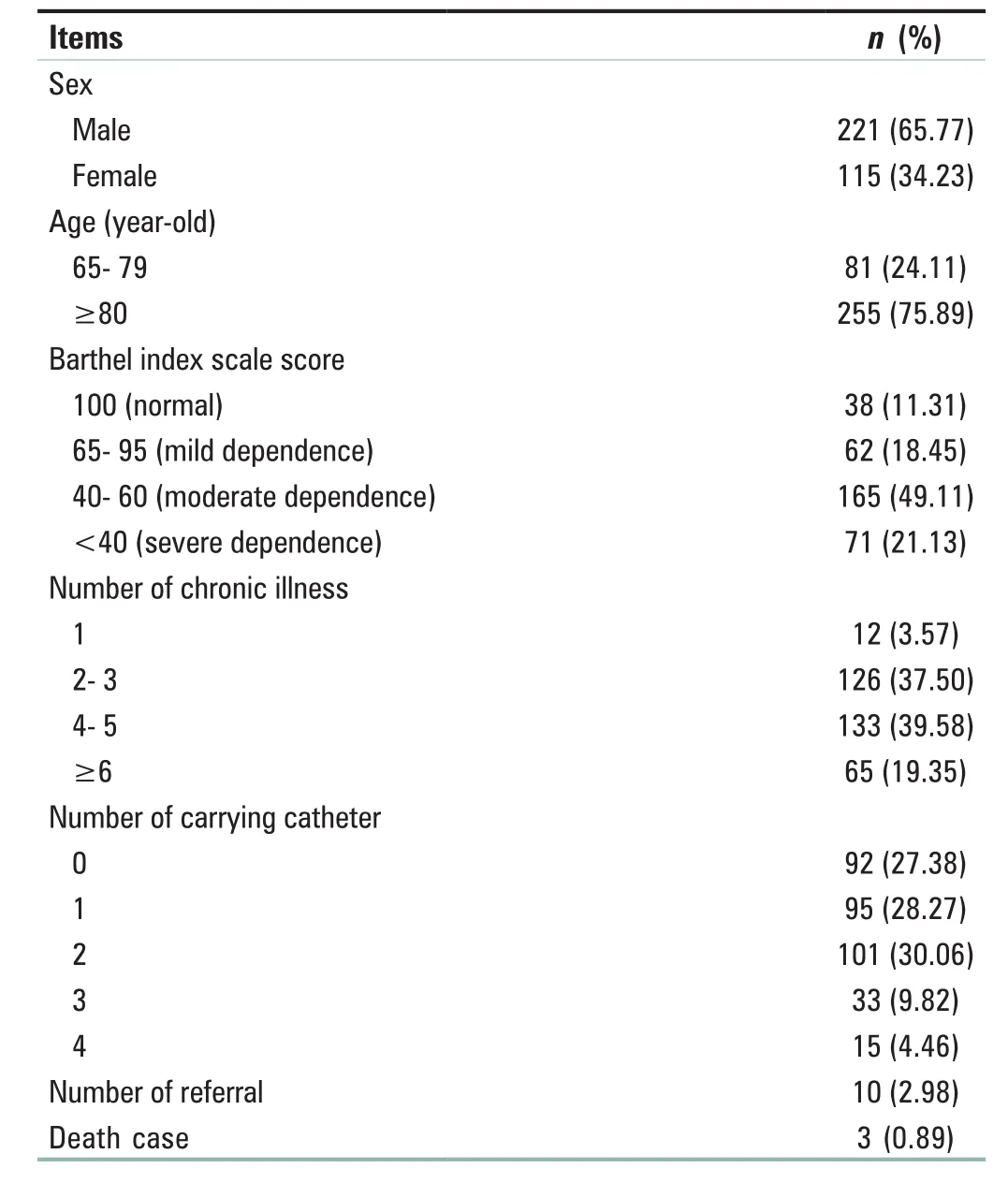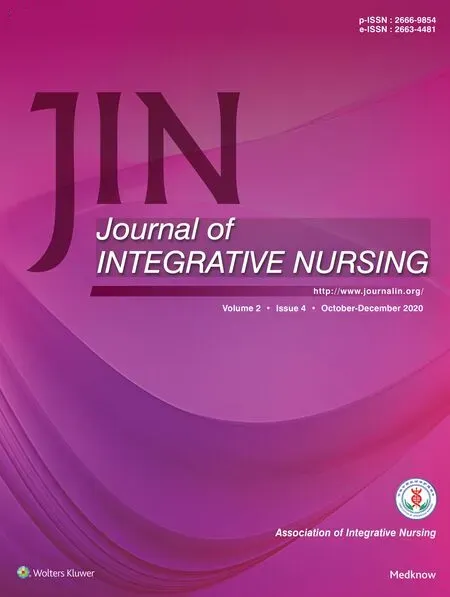Nursing administration in the geriatric department in the epidemic of COVID-19
Hui FAN, Pei-Bei DUAN, Cai-Yun NIE,Chun-Xia MADepartment of Geriatric; Department of Nursing, Jiangsu Province Hospital of Traditional Chinese Medicine, The First Affiliated Hospital of Nanjing University of Chinese Medicine,Nanjing, Jiangsu Province, China
ABSTRACT
In order to strengthen the prevention and management in the geriatric department during the pandemic of COVID-19 and to explore how to implement nursing measures to control the spread of COVID-19 to elderly patients, our geriatric department established a leading group for epidemic prevention to train the medical staffs, the patients and caregivers and implemented a set of measures such as controlling the source of infection, cutting off the transmission route, and rehabilitation nursing of Chinese medicine, thus achieved zero infection of medical staff and elderly patients.
Keywords: COVID-19, elderly patients, nursing administration, rehabilitation nursing
INTRODUCTION
It is beyond the expectation of many medical experts that COVID-19 has spread more than half a year all over the world.Nobody knows when the pandemic will disappear. Therefore,everyone should pay more attention to prevent infection of the novel coronavirus, especially the senior patients who are vulnerable.[1]Because the prognosis for the elderly with chronic underlying diseases who are facing COVID-19 is dismal,[2]the geriatric department implemented a series of effective prevention and nursing measures to control the spread of COVID-19 to elderly people under the instructions of the directors of the hospital, a 3A-Level general hospital combining Chinese medicine with western medicine.
CLINICAL INFORMATION
There are 60 fixed beds and 24 registered nurses in the geriatric department. We received 336 elderly patients with chronic illness from February to July in 2020. According to the Barthel index scale score, 298 patients’ activities of daily living including walking, washing, and toileting were worse than normal; 244 patients carried invasive catheters such as central venous catheters, gastrointestinal tubes, and urinary catheters. Their mean age is 81.50 ± 6.95 years. The average length of stay is 2–3 weeks. The general information of patients is shown in Table 1.

Table 1: The general information of patients (n=336)
NURSING MANAGEMENT
Training for medical staff
COVID-19 is a severe contagious disease of the respiratory tract that can travel roughly 3 feet or 1 m from one person to another on tiny droplets of saliva, which are produced when someone’s coughing or sneezing.[3]Medical workers play the core role of the epidemic prevention and control.First of all, we set up a team for epidemic prevention in our department. However, even some experts do not fully understand its epidemiology at the beginning of COVID-19 spreading in Wuhan, China, and no specific vaccine has yet been developed until now.[4]Due to the needs of nursing work, nurses should carry out comprehensive nursing and life care for elderly patients and have close contact with patients, which undoubtedly also increases the chance of being infected.[5]Under such circumstances, we organized the training and examination of diagnosis and treatment protocol for COVID-19 from the 1sted.ition to the 7thedition for all medical workers since the end of January 2020. We made great efforts to prevent and control the spread of COVID-19 through improving the ventilation of wards,performing strict sterilization, and formulating the process of diagnosis, treatment, and care for the elderly patients in this special period. Every staff was trained on how to wear isolation clothes and use a ventilator in case they needed to support the battle against the epidemic in the affected areas at the first time.
Controlling the source of infection
The first important thing is to control the source of infection for contagious diseases. Many elderly patients had a high risk of aspiration pneumonia and infection cause of insufficient pulmonary function and lower immunity,[6]so we disposed their secretion, sterilized the stuff they used strictly. Meanwhile, regular cell blood test, chest computed tomography (CT), and coronavirus nucleic acid test were required for each new patient. Admission can only be made if all examine results were negative. An elderly patient should also be accompanied by a caregiver with a negative report of the coronavirus nucleic acid test within 1 week. Besides,the nurse registered their basic information and does an epidemiological investigation for caregivers for expelling the infection of COVID-19. Their temperature should be monitored in the morning and afternoon every day during the stay in the hospital. All things we do are to confirm that they did not have any signs and symptoms of infection.
Cutting off the transmission route
COVID-19 is highly contagious with an acute onset.Respiratory droplets and close contact are the main means of transmission.[7]The elderly are vulnerable and at high risk of critical illness and died in this epidemic due to weakened immune function and chronic diseases.[8]Hence, strict measures were taken to cut off the ways of transmission. For example, the elderly should be guided to wash hands and disinfect items frequently. Contaminated hands are the most important transmission route in contagious diseases.[9]All of us must obey the regulations and principles of handwashing and enhance bedside isolation for those patients with multidrug-resistant bacterial infection. In addition, the elderly patients often need to be assisted by caregivers in their daily life, so we conducted healthy education for caregivers.Moreover, the elderly patients should avoid staying crowded and were reminded to wear mask when they had to leave the ward to take relevant examinations. An access control system was set up to limit the number of visitors.
Protecting susceptible people
More than 75% of patients are over 80-year-old in the geriatric department. Most of them suffered from several chronic illnesses, such as coronary heart disease, chronic obstructive pulmonary disease, diabetes, cancers, and so on. Nearly 70% of patients are moderately and heavily relying on caregivers and carrying catheters that are higher risk of infection than healthy adults. Therefore, the weak elderly patients are absolutely vulnerable populations in the COVID-19 epidemic.[10]
However, elderly patients lack typical clinical manifestations or symptoms, such as fever and respiratory symptoms,and they often cannot express discomfort properly.[11]Unexplained shortness of breath and increased rapid heart rate are sensitive indicators of respiratory infection in the elderly, so careful observation and screening are required.[12]Furthermore, the sputum excretion capacity of the elderly decreases, so sometimes auxiliary sputum excretion is needed.
Rehabilitation nursing of Chinese medicine Chinese medicine nursing technology
The study of traditional Chinese medicine shows that the elderly patients exist qi deficiency of heart, lung, and spleen in different degrees.[13]When the epidemic comes,they are more likely to show anxiety, sadness, and despair,which seriously affects their physical and mental health.[14]According to traditional Chinese medicine theory, the human body is an organic whole of various systems that need coordinated working.[15]Moxibustion, massage, and other Chinese medicine nursing technology can dredge the meridians and collaterals and improve the disease resistance of the human body.[16]Acupuncture and massage at Feishu,Pishu, Zhongwan, Shenque, Qihai, Hegu, Zusanli, and other acupoints can help patients improve physical function and regulate immunity.
Traditional Chinese qigong exercise
The clinical application in China illustrates that traditional Chinese Qigong has a certain value in the prevention and treatment of COVID-19.[17]We use these exercises including Baduanjin, Tai Chi, and Six-Word Qigong to help patients alleviate uncomfortable symptoms and get rid of bad moods.For example, Six-Word Qigong is a health-preserving method handed down in ancient China.[18]It is through the six different pronunciations named si, he, hu, xu, chui, and xi. The pressure on the chest and abdomen is different due to the different force of the lips, teeth, larynx, and tongue when people say these words combining with the smooth extension of the limbs. Tai Chi exercise is another important traditional Chinese medicine to keep the body and mood balanced.[19]It also can promote the blood circulation and strengthen the respiratory function of the lungs.[20]Overall, rehabilitation of Chinese medicine may have a large beneficial effect in older people.
Management of suspected case of COVID-19 Case 1
An 88-year-old male with cough and expectoration for 5 days accompanied by fever and dyspnea for 1 day. He was admitted to the hospital on January 27, 2020 for diagnosis of community-acquired pneumonia. The patient had no history of contact in the epidemic area, but his son came back from another city by train. He had a history of hypertension for 20 years, a blood pressure of 135/70 mmHg,a temperature of 39℃, a heart rate of 120 beats/min, a respiratory of 40/min, and blood oxygen saturation of 80%.Follow the doctor’s advice, we did the ECG monitoring and noninvasive ventilator-assisted monitoring for the patient.His blood routine examination showed that the white blood cell count was 3.8 × 109/L and the lymphocyte percentage was 45%. Chest CT showed virus pneumonia that was the suspected COVID-19. We immediately arranged a single room and provided special care for him. Medical workers on duty wore isolation clothes and N95 mask according to the isolation requirements of respiratory infectious diseases.Meanwhile, we organized medical consultation including doctors from the intensive care unit, respiratory department,and infectious division to determine whether COVID-19 is present in the patient. Afterward, COVID-19 infection was ruled out in this patient until his coronavirus nucleic acid tests were negative.
Case 2
A 65-year-old male with hypertension and abdominal distension was admitted to the hospital on May 8, 2020. He denied the contact history of the epidemic area. The patient’s vital signs and blood routine examination were normal. Chest CT showed right lung fiber nodules excluding COVID-19.However, the patient’s blood test of the coronavirus antibody was weakly positive. As soon as we knew this situation, we reported to the office of infection management, arranged throat nucleic acid test and anal swab examination for him.Fortunately, the results were negative and he was ruled out COVID-19.
CONCLUSION
Many elderly patients have frailty syndrome and self-care ability defects.[21]High-quality nursing requirements should be put forward for patients’ care during the epidemic period of COVID-19, which includes epidemic prevention and management, early identification of patients with deteriorating conditions, accurate assessment, and timely intervention as soon as possible. The last but not the least,the elderly patients should do some exercises to strengthen their immunity in order to improve the success rate of treatment and reduce mortality when possible.[22]
Declaration of patient consent
The authors certify that they have obtained all appropriate patient consent forms. In the form, the patients have given their consent for clinical information to be reported in the journal. The patients understand that their names and initials will not be published and due efforts will be made to conceal their identity, but anonymity cannot be guaranteed.
Financial support and sponsorship
Nil.
Con flicts of interest
There are no conflicts of interest.
 Journal of Integrative Nursing2020年4期
Journal of Integrative Nursing2020年4期
- Journal of Integrative Nursing的其它文章
- Effect of mild moxibustion in improving the quality of life of patients with diabetic peripheral neuropathy
- An innovative approach of using online problem-based learning and case-based learning in teaching disaster nursing during the COVID-19 pandemic
- The impact of sleep quality on reported anxiety and fatigue among shift nurses: The mediating role of resilience
- Anxiety and perception among nurses toward the outbreak of COVID-19 in University of Uyo Teaching Hospital, Akwa Ibom State
- Assessing the reasons for increase in self-medication and control measures among student nurses in University of Benin Teaching Hospital, Edo State, Nigeria
- Construction of nursing standard of integrated traditional Chinese and Western medicine for patients with COVID-19 (mild and common) in Beijing based on Delphi method
